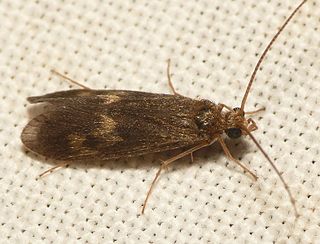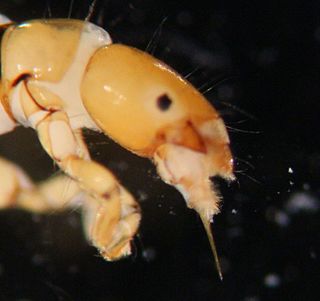
The family Leptoceridae are a family of caddisflies often called "long-horned caddisflies" or "silverhorns". Leptoceridae is the second largest family of caddisflies with over 1850 species in approximately 68 genera. The main identifying feature of most Leptoceridae is that their antennae are much longer than those of other caddisflies. There is one genus with relatively short antennae (Ceraclea), but it is easily identified by the pair of dark curved lines on the mesonotum.

The Polycentropodidae are a family of trumpet-net and tube-making caddisflies. There are at least 30 genera and 720 described species in Polycentropodidae. The type genus for Polycentropodidae is Polycentropus J. Curtis, 1835.

The Psychomyiidae are a family of tube-making caddisflies. Members of this family are typically very similar to polycentropodids, most of them can be differentiated by the spur formula is 2-4-4, thyridial cell short, absence of the forewing fork I, and hindwing forks I and IV. Male genitalia has elongate preanal appendages, and reduced tergum IX. The larvae differ by the submental sclerites separated, foretrochantin broad, and the pupal mandible apex whip-like. Larvae construct long silken galleries.

Dipseudopsidae is a family of caddisflies in the order Trichoptera. There are about 6 genera and at least 110 described species in Dipseudopsidae.

Agrypnia is a genus of giant caddisflies in the family Phryganeidae. There are about 19 described species in Agrypnia.

Brachycentrus is a genus of humpless casemaker caddisflies in the family Brachycentridae. There are at least 30 described species in Brachycentrus.

Neophylax is a genus of autumn mottled sedges in the family Uenoidae. There are more than 30 described species in Neophylax.

Stenophylacini is a tribe of northern caddisflies in the family Limnephilidae. There are at least 20 genera and 190 described species in Stenophylacini.
Amiocentrus is a genus of humpless casemaker caddisflies in the family Brachycentridae. There are at least two described species in Amiocentrus.

Macrostemum is a genus of netspinning caddisflies in the family Hydropsychidae. There are at least 90 described species in Macrostemum.

Limnephilinae is a subfamily of northern caddisflies in the family Limnephilidae. There are at least 65 genera and 600 described species in Limnephilinae.

Chilostigmini is a tribe of northern caddisflies in the family Limnephilidae. There are about 12 genera and at least 40 described species in Chilostigmini.

Dicosmoecinae is a subfamily of northern caddisflies in the family Limnephilidae. There are about 19 genera and at least 80 described species in Dicosmoecinae.

Hydroptilinae is a subfamily of microcaddisflies in the family Hydroptilidae. There are at least 60 genera and 1,600 described species in Hydroptilinae.

Anabolia is a genus of northern caddisflies in the family Limnephilidae. There are about 18 described species in Anabolia.

Oecetis is a genus of long-horned caddisflies in the family Leptoceridae. There are at least 450 described species in Oecetis.

Molanna is a genus of hood casemakers in the family Molannidae. There are more than 20 described species in Molanna.

Phylocentropus is a genus of caddisflies in the family Dipseudopsidae. There are about 17 described species in Phylocentropus.
Marilia is a genus of mortarjoint casemakers in the family Odontoceridae. There are at least 40 described species in Marilia.

Agraylea is a genus of microcaddisflies in the family Hydroptilidae. There are more than 20 described species in Agraylea.
















